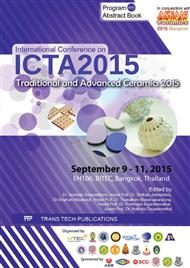[1]
J. Zhou, S. Z. Deng, N. S. Xu, J. Chen, J. C. She, Synthesis and field-emission properties of aligned MoO3 nanowires, Appl. Phys. Lett. 83 (2003) 2653-2655.
DOI: 10.1063/1.1613992
Google Scholar
[2]
S. Wang, Y. Zhang, X. Ma, W. Wang, X. Li, Z. Zhang, Y. Qian, Hydrothermal route to single crystalline a-MoO3 nanobelts and hierarchical structures, Solid State Commun. 136 (2005) 283-287.
DOI: 10.1016/j.ssc.2005.08.002
Google Scholar
[3]
C-W. Chu, S-H. Li, C-W. Chen, V. Shrotriya, Y. Yang, High-performance organic thin-film transistors with metal oxide/metal bilayer electrode, Appl. Phys. Lett. 87 (2005) 193508-193511.
DOI: 10.1063/1.2126140
Google Scholar
[4]
A. Phuruangrat, D. J. Hamb, S. Thongtem, J. S. Lee, Electrochemical hydrogen evolution over MoO3 nanowires produced by microwave-assisted hydrothermal reaction, Electrochem. Commun. 11 (2009) 1740-1743.
DOI: 10.1016/j.elecom.2009.07.005
Google Scholar
[5]
G. Wei,W. Qin, D. Zhang, G. Wang, R. Kim, K. Zheng, L. Wang, Synthesis and field emission of MoO3 nanoflowers by a microwave hydrothermal route, J. Alloy Compd. 481 (2009) 417-421.
DOI: 10.1016/j.jallcom.2009.03.007
Google Scholar
[6]
R. Liang, H. Cao, D. Qian, MoO3 nanowires as electrochemical pseudocapacitor materials, Chem. Commun. 47 (2011) 10305-10307.
DOI: 10.1039/c1cc14030b
Google Scholar
[7]
R. Naouel, H. Dhaouadi, F. Touati, N. Gharbi1, Synthesis and Electrical Properties of Well-Ordered Layered -MoO3 Nanosheets, Nano-Micro Lett. 3 (2011) 242-248.
DOI: 10.1007/bf03353679
Google Scholar
[8]
L. Maia, F. Yang, Y. Zhao, X. Xu, L. Xu, B. Hu, Y. Luo, H. Liu, Molybdenum oxide nanowires: synthesis and properties, Mater. Today. 14 (2011) 346-353.
DOI: 10.1016/s1369-7021(11)70165-1
Google Scholar
[9]
S. Bai, S. Chen, L. Chen, K. Zhang, R. Luo, D. Li, C.C. Liu, Ultrasonic synthesis of MoO3 nanorods and their gas sensing properties, Sensor Actuator B. 174 (2012) 51-58.
DOI: 10.1016/j.snb.2012.08.015
Google Scholar
[10]
T.H. Chiang, H.C. Yeh, The Synthesis of α-MoO3 by Ethylene Glycol, Mater. 6 (2013) 4609-4625.
Google Scholar
[11]
K-K. Wang, F-X. Wang, Y-D. Liu, G-B. Pan, Vapor growth and photoconductive property of single-crystalline MoO3 nanosheets, Mater. Lett. 102–103 (2013) 8-11.
DOI: 10.1016/j.matlet.2013.03.092
Google Scholar
[12]
D.Z. Pai1, K. (Ken) Ostrikov, S. Kumar, D. A. Lacoste, I. Levchenko, C.O. Laux, Energy efficiency in nanoscale synthesis using nanosecond plasmas, scientific report 3 (2013) 1-7: 1221, DOI: 10. 1038/srep01221.
DOI: 10.1038/srep01221
Google Scholar
[13]
S. Alizadeh, S.A. Hassanzadeh-Tabrizi, MoO3 fibers and belts: Molten salt synthesis, characterization and optical properties, Ceram Int. (2015), http: /dx. doi. org/10. 1016/j. ceramint. 2015. 05. 024.
DOI: 10.1016/j.ceramint.2015.05.024
Google Scholar
[14]
S. Pukird, W. Song, S. Noothongkaew, S.K. Kim, B.K. Min, S.J. Kim, K.W. Kim, S. Myung, K-S. An, Synthesis and electrical characterization of vertical-aligned ZnO-CuO hybrid nanowire p-n junctions, Appl. Surf. Sci. 351 (2015) 546-549.
DOI: 10.1016/j.apsusc.2015.05.164
Google Scholar


